
Along the coast of the Sea of Japan lies the port city of Otaru. It lies northwest of Sapporo in the northern Japanese island of Hokkaido. At dawn, on our fifth day in Japan, we decided to take a day trip (Otaru Bay Story), some 40-minute drive away.
We zipped up and pulled our hoodies over our heads. It was snowing. Soft tiny snowflakes fell on my eyelashes as we made our way to JR Sapporo bus Terminal. We walked pass many cafes and restaurants and the aroma of wholesome Japanese comfort food went up my nostrils triggering a strong desire to just stop and eat. I mustered the strength to keep walking as I had already planned to keep my stomach empty for all the delicious food Otaru is known for!
It was easy finding the Chuo Tour Bus Counter as there were signs in English; you just have to be observant. We were excited to head to Otaru, the land of the Ainu people – the original inhabitants of the land. In the Ainu language the word Otaru means sandy beach.
Over the centuries the Ainu populations dwindled due to disease and other social factors. Few of them still remain today though the exact numbers are not known. During our journey through eastern Hokkaido, we came across a few places where we spotted Ainu settlements. Their culture seemed unique and perhaps on a future visit to Hokkaido we will learn more about them.
Our bus journey started on time. We were given headphones that we plugged into the seat and turned the dial to 1 for an English audio guide. The other languages to choose from were Chinese and Korean. Accompanied by a Japanese-speaking guide we started listening to the audio narration through our headphones. To be quite honest I enjoyed the narrative. It was filled with history and description of the places we were going to visit.

As the bus passed the busy streets of Sapporo, I sank into my seat listening to the audio narration of what I believed was spoken by a person of Irish descent due to his strong accent. I enjoyed his accent thoroughly and so the story goes…
Otaru served as a major trade and fishing port. Some 400 years ago the Japanese discovered that the area was great fishing ground. There was abundance of herring and salmon and a port was built. It soon became an extremely prosperous town. The people were rich and could afford every imaginable luxury available at that time. Large mansions called Herring Mansions (Nishin Goten) sprang up all around the place. A culture started to develop around the place. The major crowd pullers at that time were Geisha and their trade flourished. Otaru was a great place to be in. But one day it all ended. The herring catches decreased and the town lost its spirit.
The city slowly started getting some of its spirit back in the 19th century after the World War 2, gas lines and power plants were laid and a new way of pioneering businessmen started creating farms, coal mining operations and fisheries. The 1972 winter Olympics put Hokkaido back on the world map and Otaru’s old buildings started attracting tourists who continue to be drawn to it, to gaze at its architecture, buy their famous glass art and crafts and sample their fabulous food – especially sashimi. I for instance fell in love with its confectionery.

The first stop was at the former main branch of the Bank of Hokkaido. It’s a grand old building built in 1912 and its characterized by some uniquely crafted stonework design. There is an air of grandeur about it. Well today this building houses a wine shop and a café called the ‘Otaru Bine.’
It’s a simple well-stacked wine shop that we entered into. We sampled a few wines and bought ourselves a bottle. For most, it may just be a walk in-walk out experience. The building its’ housed in is interesting and does stand out as a landmark in the area.


The next stop was the Otaru Canal that is lined by old brick and stone buildings, mostly warehouses. Several have been converted into restaurants or museums. We passed through one such restaurant to get to the canal. The canal looks straight out of a bygone era. The old buildings against the backdrop of falling snow and an undulating canal made it look like an amazingly romantic setting to behold. Several couples hugging each other, taking selfies or requesting others to take pictures filled the air with love and courtship. We too were carried away with the surroundings.
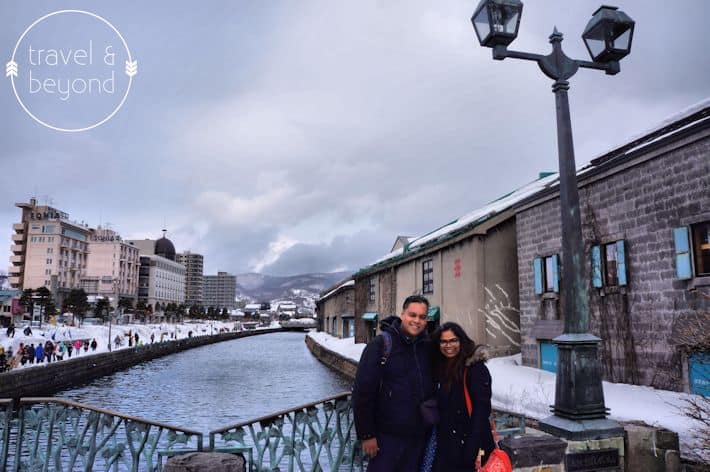


The Otaru canal is all about old world charm. Stone stairways, terraces, bridges and shops line up the old waterway. We noticed there were rickshaw rides on offer too. The streets are lined with old gaslights, though I suspect they may now be run on electricity at night. We were visiting in the morning and I think the nightlife here would be definitely amazing when lights on vegetation and illumination on old warehouses would convert this place into sheer magic. For us, we had to continue the tour but not before sampling some delicacies in the restaurants around. The tour gives you an hour to experience life around canal.
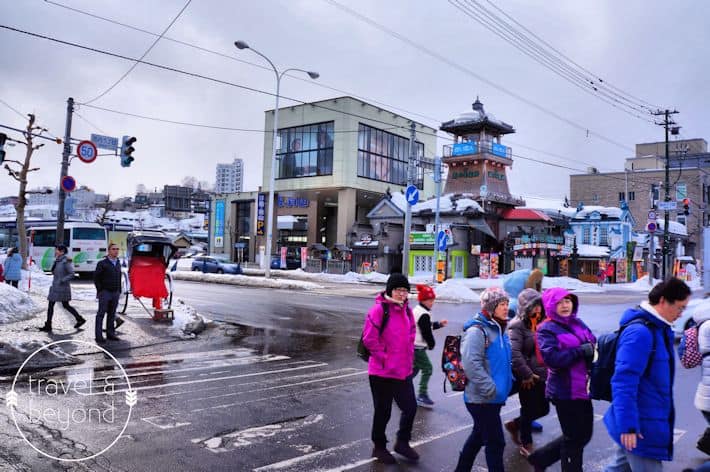

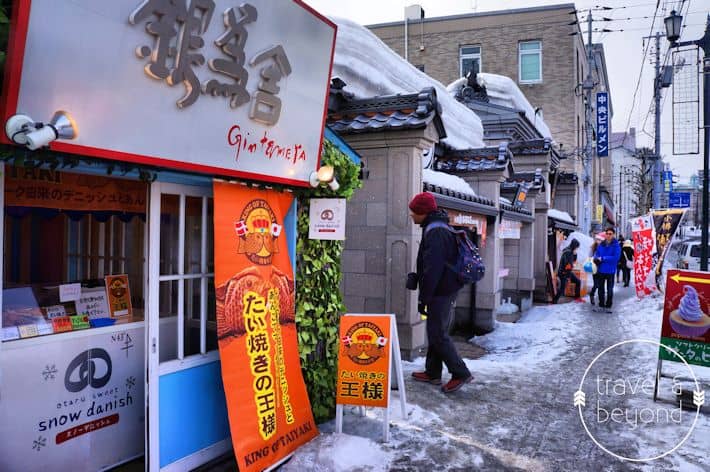

Back in the bus, we were now headed off the Grand Park Otaru Hotel for lunch. My only problem was that I had devoured several delicacies at a couple of restaurants along the canal and I was stuffed. But I must confess that on this trip to Hokkaido, I had discovered the glutton in me. My tummy seemed to tell me that there was room for more!
The buffet spread at the Grand Park Hotel consisted of Western and Chinese cuisine. From the dining area we had views of Ishikari Bay. The dishes that stood out were the roasted pork and the steamed ginger fish. Lunch is about one hour twenty minutes and we were back on the bus and headed off to the Tanaka Shuzo Kikkogura Brewery.

Founded in 1899, Tanaka Shuzo Kikkogura Brewery brews sake in a stone warehouse using new technologies that keep alive Otaru’s tradition of brewing refined Sake. The brewing process is open for public throughout the year and sake tasting is available. We were led through the whole brewing process and finally got the opportunity to taste the brew. Needless to say we purchased some Sake for ourselves.
There is more to Otaru than just romantic canals and 19th century Herring Mansions. This city is renowned for its glassworks, music boxes and sweet shops that can be found lining the bustling Sakaimachi Street. This was our next stop. I needed a walk after the excessive gluttony I displayed during lunch. But did I mention in the earlier sentence about the array of sweet shops? Hmmm…
Walking down the Sakaimachi Street, we entered some of the glassware shops. Glass works of all shapes and sizes were for sale. They were colorful exquisite pieces, beautiful to behold. But alas, we just couldn’t afford to buy any. We were told that there were many stores that let you craft your own masterpiece for a fee. But by then something else caught our eyes. Sweets!
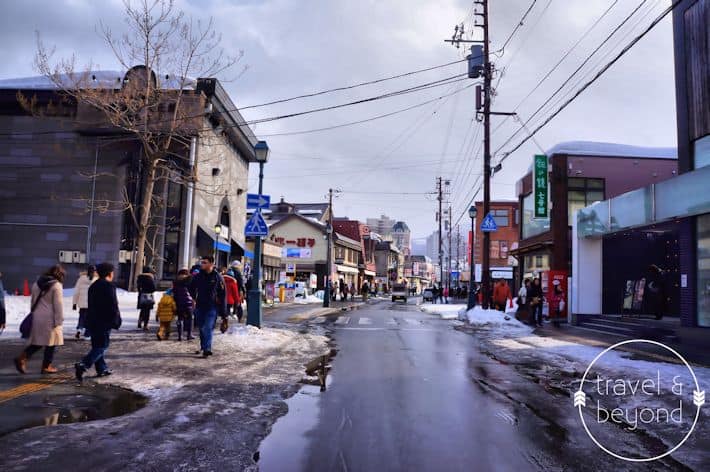

Blistering barnacles! I exclaimed as Captain Haddock would in a quaint seaport town. The sight of those sweets reignited my appetite. The most famous sweetshop here was LeTAO. Upon entering the nearest one, I saw a huge array of cakes and sweets specializing in that ever so additive creamy soft cheese called Fromage. Joseph started with a soft serve ice-cream cone that had a mix of Fromage and milk. Next, he had a soft serve that was just made of Fromage.

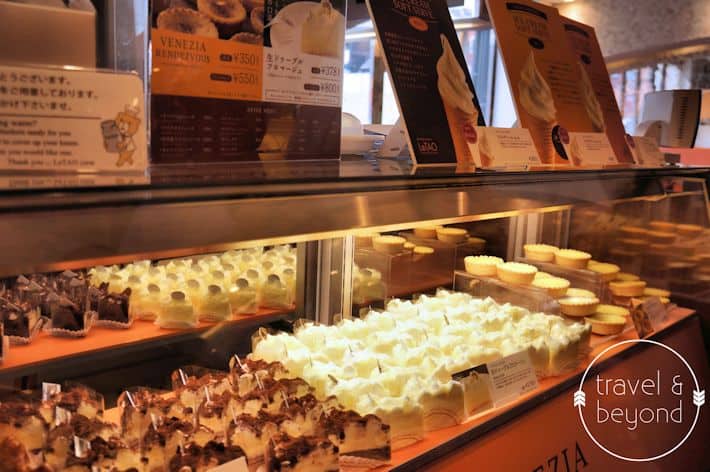

I chose Venezia Rendezvous – a brulee made from mascarpone and cream cheese. How was it? Don’t ask! I could rant forever singing voluminous praises. I will only encourage you to try it for yourselves the next time you are in Hokkaido; it’s available at the New Chitose Airport as well, where I tried it again, one last time before we boarded our flight for Narita.
At the end of the Sakaimachi Street, we entered a museum dedicated to music boxes, over 3400 music boxes from all over the world to be exact. We sat inside the museum for a bit in front of a huge Aeolian Pipe organ that was impressive!

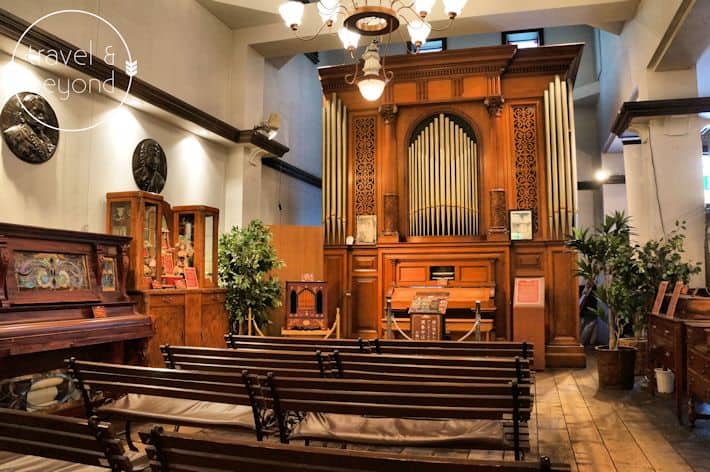
It was time for us to board our bus again. Stepping outside we saw a vintage steam clock built by the famous Canadian horologist Raymond Saunders. It was gifted by the city of Vancouver, to the city of Otaru and has since become a major landmark.
Mount Tengu was going to be the last stop for the tour before heading back to Sapporo. At an elevation of 8,681 ft., this stratovolcano is home to a popular ski slope in winter. In fact the Otaru Tenguyama Ski Resort is considered the first ski course in Hokkaido. A cable car operating since 1979 gets you to the top.
As the cable car reaches the top, we were treated to some magnificent views of the frozen surroundings. We were watching skiers gathering for a bit when we suddenly saw a large snow sculpture of Olaf – that lovable character from Frozen. After snapping a few pictures and a few snowball flinging matches later, we made our way to the top of the mountain.


A very strong breeze was blowing at the top. It wasn’t easy to stay up there for long. The snow was powdery and soft. Some places it was frozen solid and slippery. Standing on top of the mountain we gazed at the city and the seaport below. The air was hazy and pregnant with snow particles. The city lights were not lit yet, but we could imagine that at night with the lights on, the view of the city would be astonishing. The freezing strong breeze made us rush back to a restaurant for a complimentary cup of warm coffee/hot chocolate. We sat at the large windows sipping our hot brew and chatted with other fellow tourists while watching the cable car go up and down the mountain.



An hour later we got on the cable car making our way down the mountain to our bus waiting below. Soon we were seated in the bus and ready to head back to Sapporo. Our tour had ended for the day. The bus makes a couple of stops along the way at Sapporo Grand Hotel and the Sapporo Clock Tower. You can disembark if you want to explore the area at your own leisure and head back on your own expense.
We chose to head back to JR Sapporo Bus Terminal to end our wonderful day with a piping hot bowl of Hokkaido’s famous spicy miso-broth ramen!
How We Stayed Connected in Japan
The one thing I cannot live without is data connection! Whether it is for emails, social media or just keeping in touch with mom, data is the first thing I think about when planning a trip. We found it easy to just arrange for it to be picked up at the airport when you arrive by purchasing it online here.
Travel Tips
- Tour details: Otaru Bay Story
- A multilingual Chuo tour bus from JR Sapporo Station Bus Terminal is one of the best ways to visit Otaru on a day trip. The tour starts at 9.15am and finishes by 6.30pm.
- Stay at Best Western Hotel Fino in Sapporo for easy access to JR Sapporo Bus Terminal. It is a mere 3-4 minute walk.
- For more ideas on what to do in Hokkaido: (1) Try Genghis Khan (2) Explore eastern Hokkaido




LOL I think I must have stood in the same exact position for photos at the canal, we were there during the Otaru snow light path festival so it was a bit busier in the background though. I’ve never done an organised tour in Japan, I do a lot of reading and research in advance then wing it but you got to see a lot in your day so was really worth it. Such a lovely town and really nice friendly people too.
Oh yes, we did get to see a lot and that is why we love having a mixture of a tour and several day’s where we explore on our own. The confectionery in Otaru was amazing! I wished we could have stayed much longer but alas duty calls! Definitely heading back!
Wow, I didn’t realise it snowed on the ground in Japan… I guess I never really gave it much thought… a lovely post Rose.
Thank you Liz! 🙂 Hokkaido has become one of my favourite places in the world. I don’t think I had enough time to enjoy the hospitality the local people offer!
What a quaint little town. They way you describe it, it makes me think of Port Lincoln in South Australia. Tons of McMansions there built by tuna fishermen (there’s even an international airport there so that the tuna can get air freighted straight to Japan)!
Oh! I must visit Port Lincoln one day! Thank you for telling me Evangeline! 🙂
Beautiful place…
Sure is!
Japan is a magical place, even in the dead of winter … glad you enjoyed it!
It is quite impossible not to 🙂
We were just looking at exploring Hokkaido via Sapporo later in the year but balked at the idea because of the weather. Maybe thinking of bringing it forward to August instead?.. hope it might be a little more bearable for a couple of Queenslanders. Great info and pix, thank you!